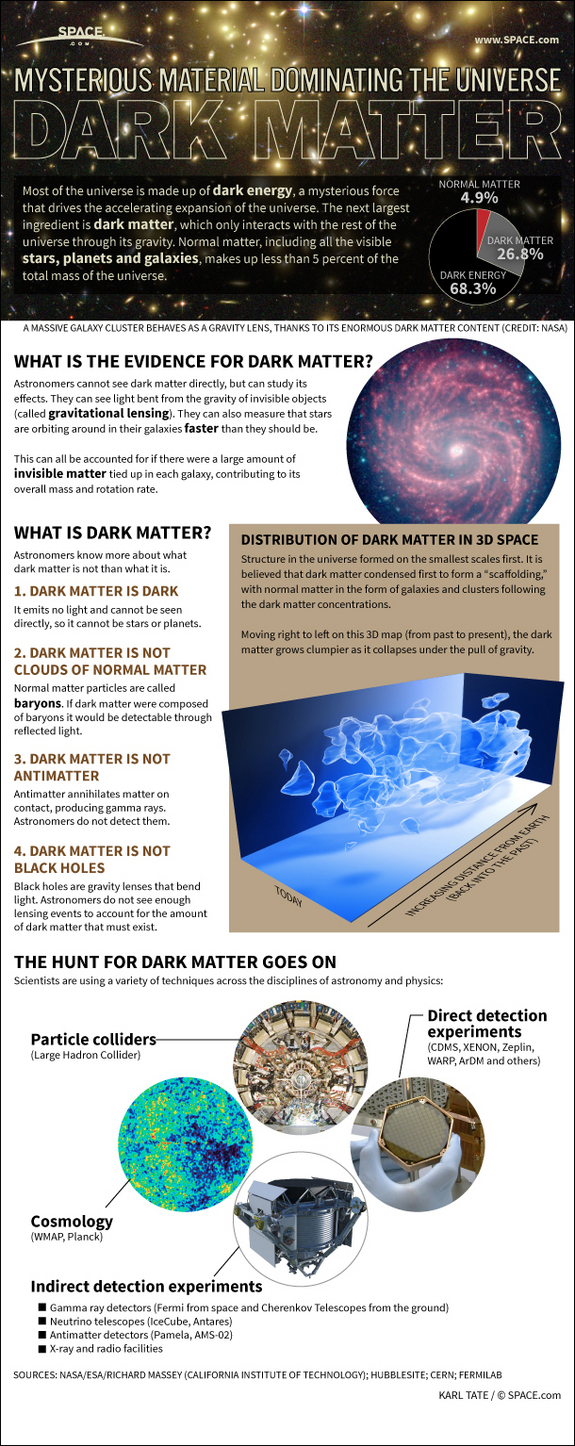
Source SPACE.com: All about our solar system, outer space and exploration
Most of the universe is made up of dark energy, a mysterious force that drives the accelerating expansion of the universe. The next largest ingredient is dark matter, which only interacts with the rest of the universe through its gravity. Normal matter, including all the visible stars, planets and galaxies, makes up less than 5 percent of the total mass of the universe.
Astronomers cannot see dark matter directly, but can study its effects. They can see light bent from the gravity of invisible objects (called gravitational lensing). They can also measure that stars are orbiting around in their galaxies faster than they should be.
This can all be accounted for if there were a large amount of invisible matter tied up in each galaxy, contributing to its overall mass and rotation rate.
Astronomers know more about what dark matter is not than what it is.
Dark matter is dark: It emits no light and cannot be seen directly, so it cannot be stars or planets.
Dark matter is not clouds of normal matter: Normal matter particles are called baryons. If dark matter were composed of baryons it would be detectable through reflected light. [Gallery: Dark Matter Throughout the Universe]
Dark matter is not antimatter: Antimatter annihilates matter on contact, producing gamma rays. Astronomers do not detect them.
Dark matter is not black holes: Black holes are gravity lenses that bend light. Astronomers do not see enough lensing events to account for the amount of dark matter that must exist.
Structure in the universe formed on the smallest scales first. It is believed that dark matter condensed first to form a “scaffolding,” with normal matter in the form of galaxies and clusters following the dark matter concentrations.
Scientists are using a variety of techniques across the disciplines of astronomy and physics to hunt for dark matter:
Astronomers cannot see dark matter directly, but can study its effects. They can see light bent from the gravity of invisible objects (called gravitational lensing). They can also measure that stars are orbiting around in their galaxies faster than they should be.
This can all be accounted for if there were a large amount of invisible matter tied up in each galaxy, contributing to its overall mass and rotation rate.
Astronomers know more about what dark matter is not than what it is.
Dark matter is dark: It emits no light and cannot be seen directly, so it cannot be stars or planets.
Dark matter is not clouds of normal matter: Normal matter particles are called baryons. If dark matter were composed of baryons it would be detectable through reflected light. [Gallery: Dark Matter Throughout the Universe]
Dark matter is not antimatter: Antimatter annihilates matter on contact, producing gamma rays. Astronomers do not detect them.
Dark matter is not black holes: Black holes are gravity lenses that bend light. Astronomers do not see enough lensing events to account for the amount of dark matter that must exist.
Structure in the universe formed on the smallest scales first. It is believed that dark matter condensed first to form a “scaffolding,” with normal matter in the form of galaxies and clusters following the dark matter concentrations.
Scientists are using a variety of techniques across the disciplines of astronomy and physics to hunt for dark matter:
- Particle colliders such as the Large Hadron Collider.
- Cosmology instruments such as WMAP and Planck.
- Direct detection experiments including CDMS, XENON, Zeplin, WARP, ArDM and others.
- Indirect detection experiments including: Gamma ray detectors (Fermi from space and Cherenkov Telescopes from the ground); neutrino telescopes (IceCube, Antares); antimatter detectors (Pamela, AMS-02) and X-ray and radio facilities.
######################################################################################

没有评论:
发表评论